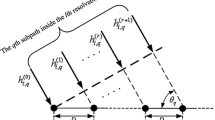Abstract
In a conventional pilot-symbol assisted modulation design, the signals of a short period are composed of the pilot tones and an information symbol block. For improving the accuracy of the channel estimate, some recurrent methods use the detected information symbols as the additional pilots. Working on an orthogonal frequency division multiplexing system, we divide the information symbol block into several sub-blocks and assign them with different data rates. Then the recurrent channel estimations can exploit the potential strength of the new approach, and the averaged data rate can be increased with the minimum mean-square error channel estimator. The simulation results confirm the merit of the proposed approach.
Similar content being viewed by others
References
Cavers J.K. (1991) An analysis of pilot symbol assisted modulation for Rayleigh fading channels. IEEE Transactions on Vehicular Technology 40: 686–693
Torrance, J. M., & Hanzo, L. (1995). Comparative study of pilot symbol assisted modem schemes. In Sixth International Conference on Radio Receivers and Associated Systems (pp. 36–41), Sep. 1995.
Kuo W.Y., Fitz M.P. (1997) Frequency offset compensation of pilot symbol assisted modulation in frequency flat fading. IEEE Transactions on Communications 45: 1412–1416
Park S.Y., Kim Y.G., Kang C.G. (2004) Iterative receiver for joint detection and channel estimation in OFDM systems under mobile radio channels. IEEE Transactions on Vehicular Technology 53(2): 450–60
Xu, Y., Su, H. -J., & Geraniotis, E. (1999). Pilot symbol assisted QAM with iterative filtering and turbo decoding over raleigh flat-fading channels. In IEEE Military Communications Conference (pp. 86–91, 1999).
Huang Y., Ritcey J.A. (2005) Joint iterative channel and decoding for bit-interleaved coded modulation over correlated fading channels. IEEE Transactions on Wireless Communicaions 4(5): 2549–2558
Lee W.C.Y. (1990) Estimate of channel capacity in Rayleigh fading environment. IEEE Transactions on Vehicular Technology 39: 187–189
Médard M. (2000) The effect upon channel capacity in wireless communication of perfect and imperfect knowledge of the channel. IEEE Transactions on Information Theory 46(3): 933–946
Lapidoth A., Shamai S. (2002) Fading channel: How perfect need perfect side information be?. IEEE Transactions on Information Theory 48: 1118–1134
Zhang, W., Xia, X. -G., & Ching, P. C. (2004). On pilot pattern design for PSAM-OFDM system. In Proceedings of the IEEE International Symposium on Circuits and Systems (Vol. 5, pp. 417–420, May 2004).
Ohno S., Giannakis G.B. (2004) Capacity maximizing MMSE-optimal pilots for wireless OFDM over frequency-selective block Rayleigh-fading channels. IEEE Transactions on Informations Theory 50: 2138–2145
Author information
Authors and Affiliations
Corresponding author
Rights and permissions
About this article
Cite this article
Yang, Y., Ma, M., Jiao, B. et al. A Design of Segmented Data Rates for Recurrent Channel Estimation. Wireless Pers Commun 50, 483–491 (2009). https://doi.org/10.1007/s11277-008-9619-6
Received:
Accepted:
Published:
Issue Date:
DOI: https://doi.org/10.1007/s11277-008-9619-6




